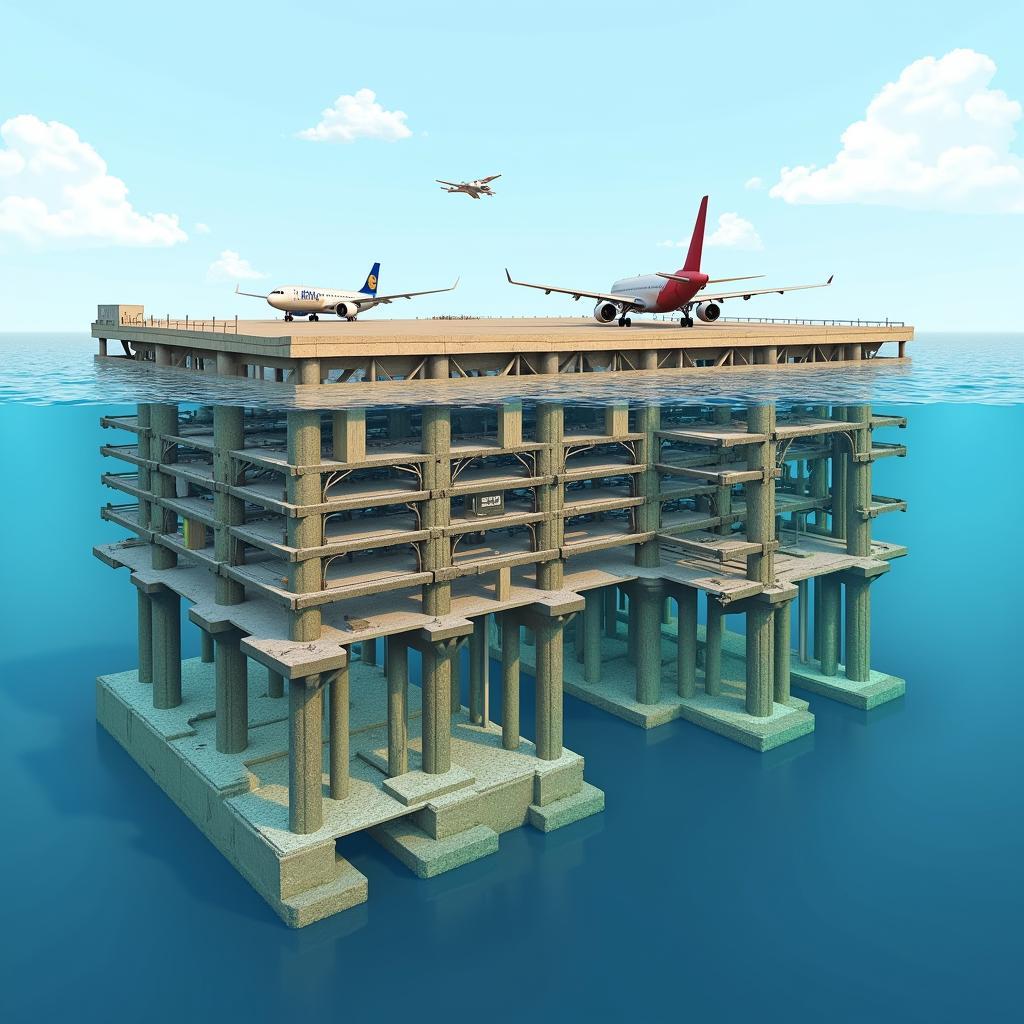Floating Airports, a concept once relegated to the realm of science fiction, are now being seriously considered as a viable solution to the growing challenges facing the aviation industry. These innovative structures, built on massive floating platforms, promise to revolutionize air travel by overcoming land scarcity, minimizing environmental impact, and offering unprecedented flexibility.
Similar to airport site selection, careful planning and evaluation are essential when building any airport. From mitigating noise pollution to optimizing passenger flow, the complexities of building a floating airport are immense. But the potential benefits are equally compelling. Imagine airports built off the coast of bustling metropolises, alleviating congestion and reducing travel time. Picture environmentally friendly airports powered by renewable energy, minimizing their carbon footprint. This is the promise of floating airports.
The Engineering Marvels Behind Floating Airports
Constructing a floating airport is a feat of engineering, requiring innovative design and advanced materials. These massive structures, typically built on interconnected pontoons or semi-submersible platforms, must withstand the constant motion of the ocean while providing a stable surface for aircraft operations. The design considerations include factors like wave height, wind speed, and tidal currents, all of which influence the stability and safety of the airport. Specialized mooring systems keep the airport securely in place, while sophisticated engineering solutions address the challenges of runway construction, terminal buildings, and other essential infrastructure.
How Do Floating Airports Address Land Scarcity?
One of the most significant advantages of floating airports is their ability to address land scarcity. As urban areas expand and populations grow, finding suitable locations for new airports becomes increasingly challenging. Building offshore eliminates the need for vast tracts of land, freeing up valuable space for other uses. This is particularly relevant for densely populated coastal cities where land is at a premium. Floating airports offer a practical and innovative solution, expanding airport capacity without encroaching on limited land resources. What is unique about floating airports compared to traditional ones is their ability to expand and adapt as needed.
 Floating Airport Platform Design Showing Interconnected Pontoons
Floating Airport Platform Design Showing Interconnected Pontoons
Environmental Considerations and Sustainable Practices
While floating airports offer numerous advantages, environmental concerns must be addressed. The potential impact on marine ecosystems, water quality, and noise pollution requires careful consideration. However, these structures also present an opportunity to implement sustainable practices. Renewable energy sources like solar and wind power can be integrated into the airport’s design, reducing reliance on fossil fuels. Advanced wastewater treatment systems can minimize environmental impact, while innovative noise reduction technologies can mitigate noise pollution for nearby communities.
Can Floating Airports Be Environmentally Friendly?
Absolutely. Integrating renewable energy sources like solar panels and wind turbines can significantly reduce a floating airport’s carbon footprint. Furthermore, careful planning and construction can minimize disruption to marine ecosystems. By prioritizing sustainability, floating airports can demonstrate a commitment to environmental responsibility. In fact, some designs even incorporate features that can enhance local marine life, such as artificial reefs built into the platform structure.
The Future of Aviation: A World of Floating Airports?
Floating airports hold immense potential for the future of aviation. They offer a bold and innovative solution to the challenges of land scarcity, environmental impact, and increasing air travel demand. While significant technical and logistical hurdles remain, the advancements in engineering and sustainable technologies are making the dream of floating airports a tangible reality. These structures could transform our cities and revolutionize air travel, ushering in a new era of sustainable and efficient aviation.
Just like nevsehir kapadokya airport, floating airports aim to serve specific travel needs. Perhaps one day, floating airports will be as commonplace as traditional airports, offering convenient and sustainable air travel to communities worldwide. As with royal jordanian airport, effective management will be essential for successful operation.
Conclusion
Floating airports represent a visionary solution to the challenges confronting the aviation industry. They offer a path towards sustainable and efficient air travel, addressing land scarcity and minimizing environmental impact. While challenges remain, the potential benefits are immense, and the future of aviation may well lie in these innovative floating structures. The concept offers a unique blend of engineering ingenuity and environmental responsibility, promising to reshape the landscape of air travel for generations to come. Think about the possibilities, and consider how floating airports could redefine our connection to the world.
FAQ
- How much does a floating airport cost to build? The cost varies depending on the size and location, but it’s typically significantly higher than a traditional airport.
- Are floating airports safe? With proper design and engineering, floating airports can be as safe as land-based airports.
- How are floating airports affected by weather? Advanced engineering solutions and mooring systems help mitigate the impact of weather.
- What are the environmental benefits of floating airports? They offer opportunities for renewable energy integration and reduced land use.
- Where are floating airports being considered? Coastal cities facing land scarcity are exploring the feasibility of floating airports.
- How do passengers access floating airports? Typically via ferries, bridges, or even potentially hovercraft.
- What are the biggest challenges to building a floating airport? The engineering complexity, cost, and environmental considerations are key challenges.
For further information on related topics, consider reading about jordan country airport and 4 star hotels in udaipur near airport.
Need assistance? Contact us 24/7: Phone: +13089626264, Email: [email protected], Address: 404 Bothwell St, Oxford, NE 68967, USA.

